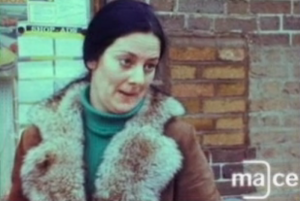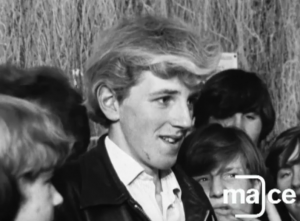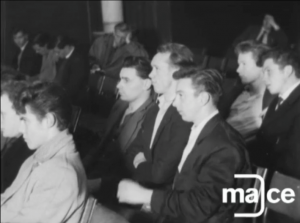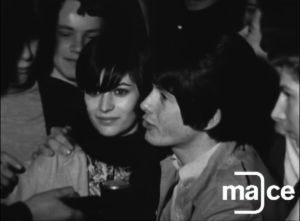The 1960s witnessed significant changes in society and a wealth of ‘permissive’ legislation. However, historians have contested the concept of the ‘permissive society’ to argue that not all of Britain experienced the effects of ‘permissiveness’ at the same time.[1] During the 1960s, the lived experience of the permissive society was limited during to the central hub of permissiveness, London. Other areas of Britain had yet to witness such changes, with the Midlands particularly remaining conservative when it came to attitudes to sex. However, in the 1970s, popular culture and the media across Britain became increasingly sexualised. This essay will analyse ATV and Central TV footage from the Media Archive for Central England (henceforth MACE). It will argue that the media exploited the idea of permissiveness, forging a general attitude that accepted the idea of the ‘Page 3 girl’, promoted by the producers of ATV and Central in the 1980s and how ‘Page 3’ when criticised was defended on the grounds of a ‘permissive society’.
The range of material on topless modelling and Page 3 available in MACE illustrates that such topics must have been popular with ATV and Central producers as well as audiences. The emergence of the Page 3 girl can be placed in the 1960s, as Rebecca Loncraine states that Page 3 had its origins during the 1960s permissive society.[2] The permissive society allowed for the development of female pin-up culture. However, its origins can be examined as part of a long tradition of newspaper pin-up features.[3] Furthermore, Adrian Bingham argues that Page 3 was an evolution from previous practice rather than a ‘revolutionary new development’.[4] This shows how sex throughout the twentieth century had long been a key selling point for newspapers. The 1960s, however, offered a valuable alibi and justification to the editors to defend Page 3 as the period witnessed an apparent ubiquity of toplessness in British culture.[5] Bingham shows how the Sun consistently defended Page 3, with editors arguing that the newspaper was doing no more than responding to the changes in contemporary culture, stating that ‘the Permissive Society is a fact, not an opinion. We have reflected the fact where others have preferred to turn blind eyes’.[6] Loncraine explores how popular newspapers have always included pin-ups, but the Sun exploited the 1960s fashion for public nudity and fused it with an older tradition of popular newspaper female pin-ups, the pictures of ‘pretty girls’ that was pioneered by the Daily Mirror in the 1940s.[7] The Page 3 girl became a regular feature in the Sun from 1970 as its introduction had resulted in an increased circulation. It was heavily publicised in this period, so much so that it became a central part of the paper’s appeal and a ‘defining symbol of British popular journalism’.[8] The breadth of coverage of Page 3 in ATV and Central programming could therefore be seen as an attempt to capitalise on the popularity of sex in the media. Thus, the idea of the ‘permissive’ society was exploited.

Although ‘provocative’ and ‘suggestive’ stories had been featured in the newspapers since the 1940s, television news reporting tended to avoid ‘sexually explicit’ content and imagery until the 1980s. Jonathan Bignell’s study illustrates that during the 1980s there was an increase in the number of programmes related to sex and sexuality, partly due to the introduction of Channel 4 in 1982.[9] The 1980 Broadcasting Act presented the statutory public service remit which required Channel 4 to be ‘innovative, distinctive, stimulate public debate on contemporary issues, reflect the cultural diversity of the UK, champion alternative points of view and inspire change in people’s lives’.[10] One of the ways Channel 4 did this was by broadcasting increasingly sexual programmes. This commitment to public service and cultural programmes meant that Channel 4 could promote these ‘sexual’ programmes as cultural whilst remaining safely within the realms of ‘respectability’ and ‘acceptability’. Simon Cottle demonstrates that the 1980s was a period that witnessed technological advance, political deregulation and ‘increased competitive and commercial pressures’.[11] Thus, ATV and Central’s preoccupation with Page 3 and topless models seems to be a result of competition with Channel 4. However, the 1981 Broadcasting Bill illustrates the nature of Channel 4 and its relationship with ITV (that operates all regional television), stating that the channels had to ‘maintain a proper balance and wide range in their subject matter’.[12] Furthermore, Cottle explains how ATV and Central incorporated the mission to report major events and happenings in line with generalized news values in the pursuit of ‘respectable news effort’, yet also sought to work with the ‘entertainers’ predisposition for “populist appeal”’.[13] This involved deliberate measures that sought to engage viewers by purposefully ‘fashioning stories in such way as to heighten their human-interest appeal’.[14] Hence, regional programming attempted during the period to appeal directly to the experiences, interests and emotional sentiments of its imagined audience.[15] Moreover, Cottle illustrates that ATV and Central news programmes were to ‘reflect what is happening in the region, likewise, it is dominated by the region’, with the Midlands region being predominantly of a working-class population.[16] Although ATV and Central did not present their programmes on topless modelling as cultural, they did present them as both ‘acceptable’ stories that appealed to the experiences of the audiences, predominantly a working-class audience in the Midlands.
The style in which the subject of topless modelling and Page 3 was broadcast by ATV and Central highlights an openness in presenting sex in the media by sexualising the female body. Many of the news broadcasts in MACE include samples of the Sun’s Page 3 images or interviews with young aspiring models, some of whom are topless. Thus, the model’s sexualised body becomes central to the interviews. Deborah Cameron argues that public debates, whether or not they be on television, about the representation of gender in popular media have tended to focus on images more than words, and especially images of the female body that are presented as a sexual spectacle.[17] The Labour MP for Birmingham Ladywood, Clare Short, drew on the images of Page 3 in a speech she made in the House of Commons in 1986 to state that they ‘portray women as objects of lust to be sniggered over and grabbed at, and do not portray sex as something that is tender and private’.[18] Certainly, Page 3 girls were presented and described in the media as food – ‘luscious Linda Lusardi, ‘dishy Helen Steed’, ‘scrumptious Sandra Jane’, ‘tasty Tracey Elvik’ – thus showing how these women were presented as objects.[19] By broadcasting such images to a wide audience, producers were illustrating their attitudes towards this notion of female toplessness and women as objects of desire. Furthermore, by presenting these images on television, producers were further exploiting the images to present a permissive society, a society which finds these images to a degree as ‘acceptable’. However, it could also be said that by ‘sensationalising’ topless models, producers, especially on Central Weekend, were pushing the topic as a ‘contemporary issue’, playing on the question of what images are private or public. Loncraine demonstrates that Page 3 during this period participated in wider debates about the nature of obscenity, about what was ‘acceptable’ to show in public and in defining what was in fact ‘public’.[20]
Vox pop footage provides us with an insight into the reactions of the general public. This element of gaining public opinion on the streets captured the reactions of both the middle and working classes on the ‘issue’ of Page 3. In a vox pop feature aired on Central Weekend in 1986, there is a lack of a dissenting voice; it is virtually absent. The tone in which this vox pop is presented highlights how Page 3 was viewed as ‘harmless fun’, as playful music is played in the background suggesting that none of the producers took the issue seriously. This is agreed upon when a model suggests that ‘I think you have to look at Page 3 with a sense of humour’.[21] Three working men when asked what they think about Page 3 and whether they found it offensive reply ‘can’t complain about that’ when showed an image of a Page 3 model.[22] It appears that the dissenting voice is pushed aside to some degree. However, some men and women interviews object to Page 3 being in the media, with two men stating, ‘I don’t think it should be in the newspapers’, going as far as to say that ‘I think it trivialises it’.[23] This shows, however, how consideration needs to be taken over how the voices of vox pops are more than likely to have been carefully selected to represent the attitudes of the producers of Central and not the entirety of the Midlands.
The footage from MACE reveals how class played a significant role in shaping attitudes towards pin-ups and Page 3 during the period. Teresa Stratford highlights how ‘class is central to the Page 3 issue’.[24] Furthermore, she states that, during the period,
Middle-class people tend not to read the Sun. Middle-class girls tend not to dream about appearing on Page 3. They have no need; most of them have job prospects which promise more interest, more respect and a long career elsewhere. It is no accident that most Page 3 Girls came from working-class homes.[25]
Notions of class are not, at first, evident in the MACE footage. However, close analysis demonstrates that Stratford’s argument can be applied to the evidence in the archival footage. Jill Neville, a young woman who appears in the Central News item ‘Young Model’, appears to have had a hard time convincing her parents that her job was ‘acceptable’.[26] Many found topless modelling ‘acceptable’ if it was presented in a certain way in the media. Neville’s father was accepting of Jill’s choice of career, ‘providing it’s done in good taste’.[27] Another Central Weekend debate in 1986 that discussed the issue of pornography sees another gentleman state, ‘I don’t see anything wrong with girls posing in Page 3. In the Sun that is done tastefully.’[28] This demonstrates editor Larry Lamb’s aim to display sex in the newspapers not in the form of pornography, but in the form of ‘tastefully posed’, ‘ordinary women’.[29] Certainly, sex could be displayed in the period. However, it had to be presented under the disguise of ‘good taste’ and as presenting the experiences of ‘ordinary women’. In the Sun and the ATV and Central footage, the majority of topless models are presented as aspirational working-class figures: attractive women who had been ‘liberated’ by glorying in their sensuality.[30] This is agreed upon by Bingham and Conboy, who state that these models were ‘aspirational figures’, and that the media exploited this image to emphasise how many young women sought to be topless models.[31]

A Central News East report demonstrates how young models wanted to follow in the footsteps of one of the biggest Page 3 models, Samantha Fox, stating that ‘thousands’ wanted to be a topless model.[32] This illustrates how the younger generation of women were ‘not ashamed to bear all’, highlighting how permissiveness had altered the younger generation.[33] If there was a dissenting voice, then it often came from the older generation, who had more conservative values. Parents and families of models, however, were accepting of the choice of career, as it was a career for working-class women. In an interview, Samantha Fox stated that ‘all of my family is proud of me, we all came from a working-class family, so for one of us to do well has really brightened up the family’.[34] This suggests that there was a lack of opportunities for young women during the period. One model stated that ‘it’s nice to be noticed’, suggesting society’s disregard for working-class women during the period.[35]
The reaction to Page 3 in the 1980s reveals dissent in how women were presented in the media. Bingham demonstrates that Page 3 girls and the debates surrounding them reveal much about the contemporary attitudes to women and to public sexual display.[36] Interestingly, Loncraine highlights how the Sun’s mascot of Page 3 was designed to provoke a response from various groups outside its target readership of the working class. Editors of the Sun clearly wanted a reaction from the middle-class members of society, and they got one.[37] Criticism from establishment figures on moral grounds was welcomed by editors, as it validated the Sun’s aim of being a ‘permissive’ newspaper.[38] However, what was not accepted was feminist criticism, as MP Clare Short found out in the 1986 when she took a bill to Parliament that would ban Page 3 girls from newspapers. Feminists such as Short felt that Page 3 was pornography, emphasising how it ‘institutionalises the sexual subordination of women to a mass market, cheaply and on a daily basis, and should therefore be relegated to pornographic magazines’.[39] The criticisms during the period were not grounded in ‘morality’, but in feminist arguments about women being ‘demeaned’ and ‘stereotyped’.[40] A Central Weekend debate taking place shortly after Clare Short addressed the Commons with her bill reveals how Midlands television wanted to present the attitudes of ‘ordinary’ people, Page 3 models and Clare Short towards the bill the topic of Page 3 in general. The debate draws on how women as Page 3 models were stereotyped as ‘dumb’, ‘topless’ and ‘brainless’.[41]

As a result of these criticisms, the popular press was forced to develop a new language to defend their pin-ups.[42] Stratford shows that the women who criticised the papers for featuring Page 3 girls in contrast were called ‘boring’, ‘dowdy prudes’ and were secretly jealous that they did not possess the girls’ ‘wonderful figures’.[43] Clare Short was the main target of this abuse and was subjected to repeated insults by the tabloid press. Stratford has shown that Short’s objections to Page 3 were described as an ‘overreaction’, and that Short’s bill and the support for the bill by other feminists was treated as a ‘sign of panic’.[44] The tabloid press made many references to Short’s physical appearance, naming her ‘the buxom Ms Short’.[45] The popular press, particularly the Sun went as far as to suggest that she was not quite sane, with its ‘Crazy Clare’ campaign.
The Sun’s campaign suggests how the popular press and Midlands television portrayed the Page 3 girl as part of the ‘fabric of British culture’.[46] Stratford draws on this to illustrate that Page 3 by the 1980s appeared to be firmly entrenched in popular culture, going as far as to state that ‘it seemed an institution’.[47] This can be seen in the footage of Central Weekend, as Page 3 model Lindy states of the bill, ‘I would have thought that it’s a total waste of time. Page 3 has been running very successfully for so many years now.’[48] Moreover, other Midlands television footage demonstrates how Page 3 and topless models were viewed as an institution and a part of Britain’s permissive culture. An ATV Today report from 1976 reveals that pub stripper shows had already ‘been going on for a long time’ in the Midlands, with a father of a topless model interviewed on Central News East suggesting that topless women were the norm by stating ‘that’s life 1986, 1987, in’t it?’.[49] This illustrates how Page 3 during the 1980s was able to withstand the resurgence of the feminist movement, as the female pin-up tradition was firmly entrenched within society and the male-dominated Fleet Street, and their newspapers had enough ‘cultural power’ to deflect the criticisms of Short.[50]
To conclude, the majority of the public accepted Page 3, highlighting that to some degree society had become ‘permissive’ by the 1980s. The Central TV and ATV footage illustrates that there was some level of freedom to display sexualised images on television, suggesting that society had progressed from its conservative views and values during the 1950s and 1960s. This was in part due to the increase of sexualised imagery presented in the media. As a result, the British public became exposed to sex in their everyday lives, whether it was through newspapers or television. Yet, permissiveness did not reach the whole of society and there were still those who objected to Page 3, sexual imagery, and how women were represented in the media. The coverage of Page 3 by ATV and Central by itself cannot suggest a complete timeline of permissiveness. It does, however, demonstrate how the Midlands, particularly working-class people, perceived Page 3. Furthermore, it shows the development of the permissive society by the 1980s. Even though Page 3 faced dissenting voices from both the members of public and feminists such as Clare Short, the institution was able to withstand the backlash. This shows that by the 1980s Page 3 had become so firmly entrenched within society, it had become part of the ‘British way of life’.
Notes:
[1] See Dominic Sandbrook, White Heat: A History of Britain in the Swinging Sixties (London, 2006) and Arthur Marwick, The Sixties: Cultural Revolution in Britain, France, Italy and the United States, c. 1959-1974 (Oxford, 1999).
[2] Rebecca Loncraine, ‘Bosom of the Nation: Page Three in the 1970s and 1980s’, in Mina Gorji (ed.), Rude Britannia (London, 2007), 96-111 (96).
[3] Adrian Bingham, ‘Pin-Up Culture and Page 3 in the Popular Press’, in Maggie Andrews and Sallie McNamara (eds.), Women and the Media: Feminism and Femininity in Britain, 1900 to the Present (New York, 2014), 184-198 (185).
[4] Ibid.
[5] Ibid.
[6] Adrian Bingham, Family Newspapers? Sex, Private Life and the British Popular Press 1918-1978 (Oxford, 2009), 222.
[7] Loncraine, ‘Bosom of the Nation’, 97.
[8] Bingham, Family Newspapers, 202.
[9] Jonathan Bignell, An Introduction to Television Studies (London, 2004), 239.
[10] ‘What is Channel 4?’ [online source] https://www.channel4.com/corporate/about-4/who-we-are/what-is-channel-4 accessed on 3 May 2018.
[11] Simon Cottle, TV News, Urban Conflict and the Inner City (London, 1993), 38.
[12] ‘Broadcasting Act 1981’, 1981 [online source] http://www.legislation.gov.uk/ukpga/1981/68/pdfs/ukpga_19810068_en.pdf, accessed on 3 May 2018.
[13] Cottle, TV News, 64.
[14] Ibid.
[15] Ibid., 65.
[16] Ibid., 67.
[17] Deborah Cameron, On Language and Sexual Politics (London, 2006), 29.
[18] Clare Short, Commons Sitting, 12 March 1986, Parliamentary Debates, Commons, Vol. 93 (1986), c. 937-940.
[19] Teresa Stratford, ‘Page 3- Dream or Nightmare?’, in Kath Davies, Julienne Dickey and Teresa Stratford (eds.), Out of Focus: Writings on Women and the Media (London, 1987), 57-62 (60).
[20] Loncraine, ‘Bosom of the Nation’, 96.
[21] Central Weekend [Programme 11], ‘Page 3 Debate’ (ITV, 18/4/1986), Media Archive for Central England (hereafter MACE), University of Lincoln, https://vimeo.com/240812056 (log-in required).
[22] Central Weekend, ‘Page 3 Debate’.
[23] Central Weekend, ‘Page 3 Debate’.
[24] Teresa Stratford, ‘Women and the Press’, in Andrew Belsey and Ruth Chadwick (eds.), Ethical Issues in Journalism and the Media (London, 1992), 130-136 (131).
[25] Ibid., 131.
[26] Central News East, ‘Young Model’ (ITV, 17/11/1986), MACE, University of Lincoln, https://vimeo.com/152979170 (log-in required).
[27] Ibid.
[28] Central Weekend [Programme 18], ‘Pornography Industry Debate’ (ITV, 20/6/1986), MACE, University of Lincoln, https://vimeo.com/236076287 (log-in required).
[29] Patricia Holland, ‘The Politics of the Smile: “Soft News” and the Sexualisation of the Popular Press’, in Cynthia Carter, Gill Branston and Stuart Allan (eds.), News, Gender and Power (London, 1998), 17-33 (23).
[30] Bingham, ‘Pin Up Culture’, 193.
[31] Adrian Bingham and Martin Conboy, Tabloid Century: The Popular Press in Britain, 1896 to the present (Oxford, 2015), 158.
[32] Central News East, ‘Penthouse Roadshow’ (ITV, 9/5/1986), MACE, University of Lincoln, https://vimeo.com/153085506 (log-in required).
[33] Central News East, ‘Penthouse Roadshow’.
[34] ‘The Story of Page 3 Girls’ (1985), YouTube, https://www.youtube.com/watch?v=2aT5HUzz06k.
[35] Central News East, ‘Penthouse Roadshow’.
[36] Bingham, Family Newspapers, 203.
[37] Loncraine, ‘Bosom of the Nation’, 104.
[38] Bingham, ‘Pin-Up Culture’, 194.
[39] Clare Short, Dear Clare… This Is What Women Feel about Page 3 (London, 1991), 43.
[40] Bingham, ‘Pin-Up Culture’, 186.
[41] Central Weekend, ‘Page 3 Debate’.
[42] Bingham, ‘Pin-Up Culture’, 186.
[43] Stratford, ‘Women and the Press’, 131.
[44] Ibid, 132.
[45] Ibid.
[46] Bingham, ‘Pin-Up Culture’, 184.
[47] Ibid.
[48] Central Weekend, ‘Page 3 Debate’, https://vimeo.com/240812056 (log-in required).
[49] ATV Today, ‘Lunchtime Strippers’ (ITV, 11/2/1976), MACE, University of Lincoln, https://vimeo.com/153086574 (log-in required); Central News East, ‘Young Model’.
[50] Bingham, ‘Pin-Up Culture’, 195.









You must be logged in to post a comment.